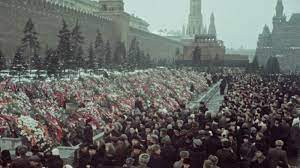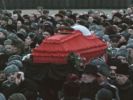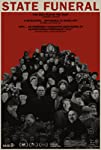Eye For Film >> Movies >> State Funeral (2019) Film Review
State Funeral
Reviewed by: Andrew Robertson

This is not the only film that features Stalin's interment. Though one wonders if internment might be more accurate. Such is the volume of pomp and ceremony dedicated to demonstrating that he was actually dead.
State Funeral is not rushed, but it feels trite to call it elegiac. It is a monumental assemblage, both before and behind the camera. Sergei Loznitsa writes, directs, Danielius Kokanauskis deserves plaudits as editor. There are some 160 credited Directors of Photography. I say 'some' as even on the big screen my count was not more accurate than perhaps 23 rows in each of 8 columns.

The title is State Funeral but it's a very particular version of 'State'. The Russian title is, after some research, using the same root of 'state' that informs 'state-owned', 'governmental standard'. It might be nothing, but the word means different things in English depending on how it is capitalised and Russian is often more subtle. Beyond that, of course, when we talk of individuals and states we must consider Louis XIV. He claimed to be the state, but no battle for Louisville consumed two million souls.
This is 135 minutes of archive footage of "the Great Farewell", and that undermines the skill and scale and craft of it. There are sequences where we move from one camera to the next to follow the same action. This is complex enough in conventional film production, but it is rare for first and second units to be able to send the other to the gulag.
The film considers the architecture of authority well. I can't say I'd realised before how simultaneously large and compact Red Square actually is, that it's a straight shot from tomb to GUM. There is a constant air of unreality. Not just the possibility of Potemkin pallbearing, but the projection of strength.
There is footage of traffic, the same car threefold, a street lined with the same truck, nose to tail. So close that individual markings are subsumed to produce the sense that someone has clicked and dragged a chain of them. Without airbrush or the tools of the photo shop it takes a moment to realise that the ragged wave of uniform grey that separates one mass from another is a line of soldiers. The Army is everywhere and nowhere. Old generals carry cushioned medals before the funerary party and no uniforms appear upon the balcony. As Stalin lies surrounded by a tide of tributes, a floral flood, crowds walk past to pay homage. They look to Stalin, the guards look at them. They know he is dead already, they are there to watch.
Eyes catch the cameras and look away. The cameras catch eyes that fill with tears, lips that tremble, brows that furrow. The cameras catch delegations from around the world, lockstep men from countries that no longer exist stepping from planes that are copies of copies. The delegations bring wreaths and bouquets that dwarf those who bear them. Colour footage suggests that no blossom East of the Urals was left, every petal plucked and trucked to assemble Buketgrad.
The watching, the catching of glances, becomes overwhelming. Meditative and oppressive, the latter literal. There is speechifying from lecterns flanked by lathes. There is a moment's silence on an otherwise empty forestry trail. Great gouts of ack-ack acknowledge the absence.
Funerals have ever given space to the survivors to think, and here we have it doubled. You watch the faces of the crowds in 1953 and think about what they have seen. Step by step they file past the body, steppe by steppe the cameras visit the other SSRs to update their files, stop by stop the body is filed past the city to lie in state and then repose.
You think about other funerals, and inevitably death. You see men who have killed and will kill, not just in uniforms, on crutches still, but banal bank managers of murder. Beria is among those who speak, the committee recognises and so on and so forth. Politeness from the Politburo, the bureaucracy of bereavement, but out of sight, not out of mind, the white-tile of tyranny, the terror.
The camera looks across a city and you cannot tell where roofs end and rubble begins. The camera looks across the city and you realise that the gutters and eaves are crawling with onlookers. The camera looks across the smithy and the machines are stilled. The camera looks across the quarry and a portrait larger than a man swings steadily across, scattering workers in its path.
There are infants and the elderly, conscripts and commanders, widows and wounded, orphans and officers, between them and the body there is a tension barrier - a line of attendants who are both watching and watched. There is sound, speeches, music. Tchaikovsky, a children's lullaby. Ask not for whom the dear jingle bell tolls, little sparrow, it tolls for Stalin.
Watching washes over us, the watchers. Every portrait the same, every wreath the same, every flag the same, every flag topped with the same finial spearpoint with hammer and sickle, everything stamped by the same die, the same boot. The funeral itself not just a function but with function, a demonstration that the Man of Steel is and remains dead. The medical detail over the radio, the presentations to the workers, the act of documentating the day. It is a monumental assemblage, both before and behind the camera.
The craft of Loznitsa and his colleagues are in curation as much as carving, in the finding and fitting. There are moments that are wrenching in their enormity, no calipers could compass the power of the proceedings but footage can measure it. At the end, in crisp font, statistics of Stalin's casualties, a note about the cult of personality and the reburial in 1961. There is a beginning, a middle, and an end, but the story is not the coffin arriving in a van and leaving on a gun carriage.
The story is everything around that penultimate progress, and that is what we are given to watch. The craft here is multifaceted, but piece by piece we are given a foothold in an era, an event, and its ending. It is slow, necessarily so, building to a last step of heel on granite. Its tread is measured to the last.
Reviewed on: 17 Jul 2021


















